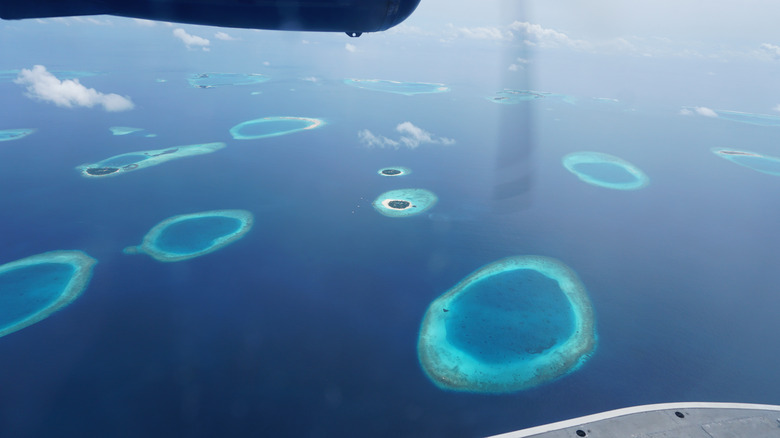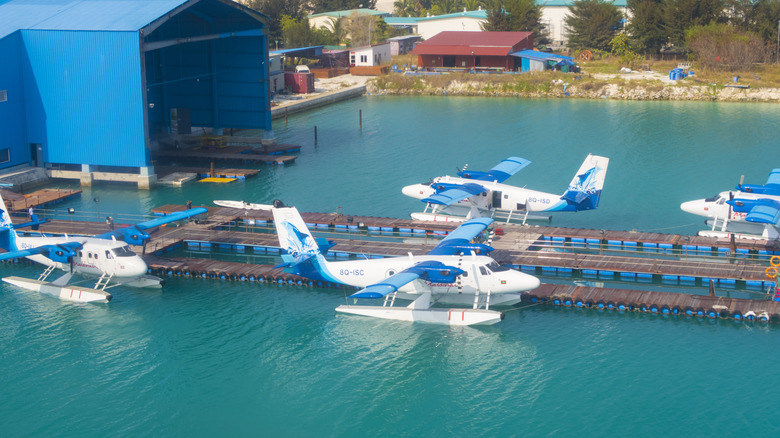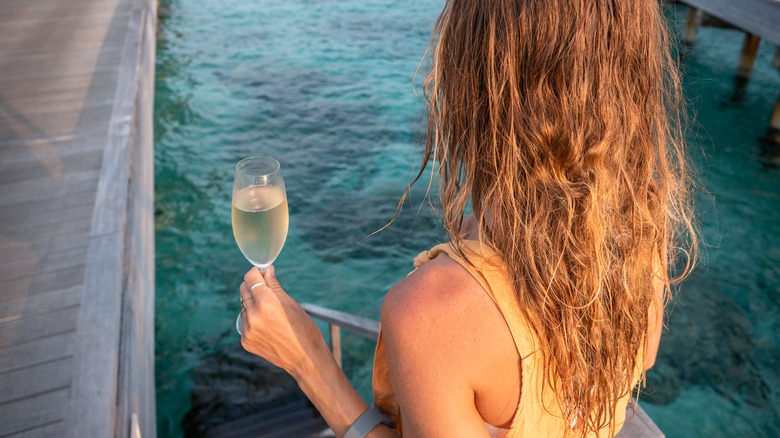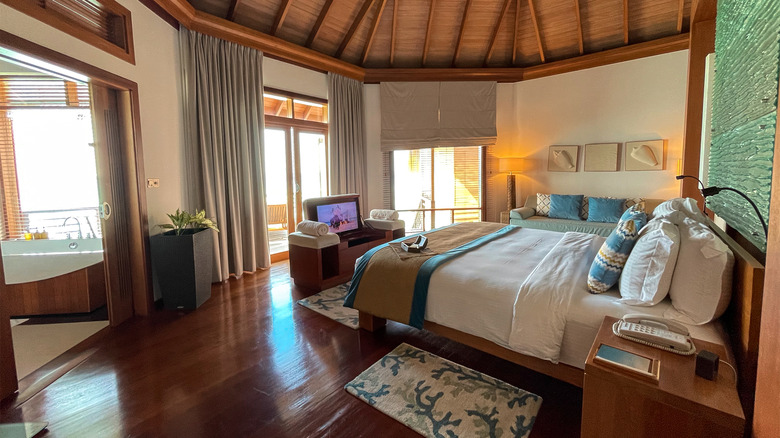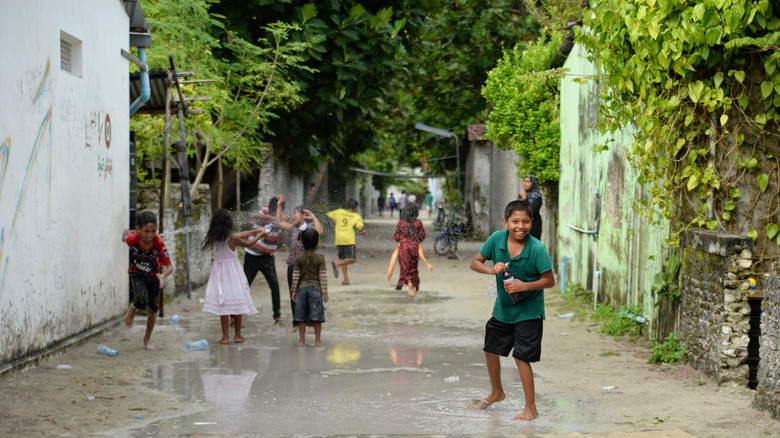10 Crucial Details To Know Before Visiting The Maldives
In the Maldives, the image of a bungalow hovering over the crystal-clear waters of a turquoise lagoon has become a visual shorthand for the country's idyllic vacation backdrops. Influencers and celebrities walk the boards of extravagant hotels, throwing open doors to luxurious accommodations with uninterrupted views of the horizon. For many travelers, it's an aspirational trip to paradise. But if you consider yourself more on the adventurous side, you might be wondering — is there anything to actually do and see in the Maldives besides sitting on the beach?
What the algorithm doesn't usually show you is that the Maldives is even more beautiful underwater than it is above it. Every lagoon-fringed island has a reef that is more than likely teeming with colorful tropical fish. You can make excursions to magical bays filled with dozens of manta rays, or you may need to pick up and go when the call comes in to spot a roaming whale shark, one of the sea's most gentle giants. There are also many ways to connect more deeply with Maldivian culture and learn more about the history of this fascinating country. On top of this, there are a few essential details to be aware of before you cross the globe to arrive in the Maldives, which I wish I had known before my own trip to this unforgettable and worth-seeing destination. Here's what you need to know about getting around, traveling on the cheap, and respecting local laws.
There are over a thousand islands
Located in the northern part of the Indian Ocean, the Maldives is a nation that consists exclusively of islands, grouped into small clusters, also known as atolls. These include sandbanks, and it's estimated that of the approximately 1,200 coral islands, fewer than 200 are inhabited. There are surrounded by atolls, which were formed by an ancient volcanic mountain range that forms a narrow ring shape that spans about 500 miles from north to south. The majority of islands are deserted, but 200 of them are inhabited — out of which there are over 90 resort islands to choose from.
Many of the islands in the Maldives were also constructed using sand from the seafloor to build "artificial" islands. These include Hulhumale, which is where you'll find Velana International Airport (MLE), the entrance point for all international travelers flying into the Maldives. It's connected to the capital city of Malé by bridge, but most people will go straight from the gate to the seaplane terminal or speedboat marina.
The exact number of islands in the Maldives is always in flux. Because so many of these islands are quite low-lying, the Maldives is on the front line of climate change and rising sea levels, and many islands struggle with erosion and flooding during extreme weather events. Ironically, as the country faces the loss of its natural islands, it is constructing more artificial islands specifically for the purpose of hosting resorts like the Hard Rock Hotel.
The only way to get around is by speedboat or seaplane
If you're booking your accommodation anywhere except for the capital of Malé, you will need to arrange for transportation after you land at the international airport, either by seaplane, speedboat, or ferry. When traveling to a local island in another atoll, you typically have to transfer through the local ferry terminal in Malé. Resort guests may arrange a speedboat transfer directly with the hotel, though the hotel may not include the cost of this in your stay. Boats depart directly from the airport, and although it depends on how far the resort is, expect a ride time of 20 minutes to two hours.
Seaplanes are a much faster way to travel, especially if you pick a resort on a distant atoll, and the seaplane terminal is right next to the international airport. There are a few different seaplane companies — Manta Air and Trans Maldivian Airways — but some higher-end resorts like the Four Seasons operate their own private planes. Every resort and hotel is different, so when you book, get in contact with the hotel immediately to make sure you understand what's included and what you will have to book separately. Before you lock in that distant resort, consider the cost of a seaplane ticket, which can cost anywhere between $250 and $900 round trip. Because seaplanes don't fly at night and schedules can change day to day depending on the weather, it's highly recommended that you plan to land in the morning when you first arrive in the Maldives.
Alcohol is forbidden on local islands but okay at private resorts
Islam is the state religion of the Maldives, which means you will encounter strict rules on local islands. Except for live-aboard boats, which cater to scuba divers, and private island resorts, alcohol is strictly prohibited and controlled. Guests are not allowed to bring alcohol when leaving the resort — if they are going on a wildlife excursion, for example — and they will not be allowed to travel with alcohol between resorts. Basically, if you want to make sure you can drink on your vacation, you will need to book a hotel on a private island, and not a local island. And if you order a bottle of champagne, make sure to finish it before you check out.
In addition to alcohol, pork products are also strictly controlled with respect to the national religion, and it's illegal to import them unless they're shipped directly to the resorts. On these private islands, you can find pork dishes. If you're looking for bacon at the buffet, you may need to ask someone because it will sometimes even be slightly hidden from view.
Contraband items like alcohol, or maybe a packet of jamón if you're stopping over in Spain, will be confiscated at the airport, even if you bought it duty-free. However, you can sometimes get it back upon leaving the Maldives. Make sure to keep any receipts that the authorities give you and claim your confiscated items before you check in.
Local islands have cheap accommodation, but stricter rules
The Maldives doesn't have to be an expensive vacation if you travel exclusively to local islands. If you don't need an overwater bungalow or private beach access, there are plenty of budget-friendly guesthouses on local islands that will cost you between $50 and $200 USD per night. You will be embedded among the local community, so you can find a deeper connection to the country, and like the big resorts, guesthouses can help you arrange transfers and excursions. However, on local islands, you won't be able to cool down with a beer.
Women, depending on which beach they go to, will have to abide by the dress code for swimwear. Unless a beach is specifically designated for tourists, women are not allowed to swim in revealing clothing, and men must wear knee-length shorts and T-shirts. Women don't have to cover their heads, but it's recommended that they be covered from shoulder to elbow with a dress or pants that go past the knee. On bikini beaches, which you can usually find easily because they will be named "Bikini Beach," you're free to wear whatever style of swimsuit you'd like. Nudity is not allowed on either local or resort islands.
Travelers find that staying on a local island gives them a more authentic experience, and now resorts like Milaidhoo have begun offering day trips for hotel guests led by local guides. These have some of the best overwater bungalows.
It is one of the world's best snorkeling destinations, and wildlife is fiercely protected
The coral reefs in the Maldives are some of the most colorful and lively in the world, with thousands of species of tropical fish whose colors will blow your mind. It's a mecca for divers and snorkelers who come to spend their vacation visiting the underwater world and interacting with creatures as large as manta rays, whose wing spans can reach as wide as 26 feet. One of the best places to swim with these gentle giants is Hanifaru Bay, which is also one of the Maldives' strictly regulated marine reserves.
This is one of the country's Marine Protected Areas, which means fishing is either restricted or banned, and eco-conscious tours are controlled. For example, in Hanifaru Bay, visitors are only allowed to spend 45 minutes with a guided tour, and rangers are on-site to monitor wildlife interactions and ensure that every snorkeler (diving is prohibited here) maintains a proper distance and refrains from touching the wildlife.
Many hotels also participate in coral restoration, such as Milaidhoo, a private resort in the Baa Atoll that organizes excursions to Hanifaru Bay. Guests will plant their own corals in the lagoon below the overwater villas, and can leave their mark on their property in a sustainable way. Restoration programs like these are becoming more common throughout the country and are available at numerous resorts, but at Milaidhoo, you can snorkel through and read messages from past guests.
You can get scuba certified on vacation
If you've always been scuba-curious but haven't found the time to get certified, you'll have plenty of opportunity in one of the world's diving meccas. There are dozens of PADI-certified dive centers and resorts in the Maldives, where you can start the process of getting Open Water Certified. This is the first level of certification that allows you to dive down to 60 feet, which is more than deep enough to appreciate the underwater wonderlands of the Maldives. You'll need at least two days to complete the course on location, but you can complete the eLearning portion of the certification before your trip. Instead of doing your training dives in the local pool or murky waters of your local beach, you can relish the chance to spot a sea turtle or a few stingrays on your very first ocean dive.
Look for resorts with standout dive centers like Baros, which is best known for its house reef filled with friendly and smallish black-tip sharks. Just bear in mind you'll need to dedicate your time to attending lessons, and you'll save the most time if you complete the online course before you arrive. If you're short on time, you can do a trial dive, which will allow you to experience the sensation of scuba diving with an instructor by your side the whole time. If you can't find the time, it happens to be one of the best islands for snorkeling in the world.
Right under the equator, UV rays are strong, and you will need to pack reef-safe sunscreen
The equator cuts straight across the Maldives, although most of the islands are within the northern hemisphere. Not only does this mean that it's always hot, with temperatures ranging between 80 and 88 degrees Fahrenheit year-round, but the UV index is also much higher than you might be used to, usually between 11 and 12. To put that into perspective, the average UV index in Miami is between 6 and 8 in the winter months and only reaches 11 in the summer.
Because the sun's rays can be quite damaging, be diligent about applying sunscreen and bringing sun protection. If you plan to do a lot of snorkeling, a rash guard is a great investment because it's easy to lose track of time and forget to reapply. Swimmers should be mindful that many sunscreens are made with ingredients that are toxic to the very fragile corals and can contribute to bleaching events. Many resorts require that you use certified reef-safe sunscreen, which is usually mineral-based, and this is what you'll usually find for sale in the shops when you arrive. Not to mention, these tend to come at a premium price because you'll have no other shopping alternative. Even though the weather is always warm, you'll need to consider the clouds if you want to figure out the best time of year to visit the Maldives.
It's home to some of the world's top luxury resorts
There is no shortage of top-shelf luxury in the Maldives, which has set new global standards for luxury. Top hotel brands such as The Four Seasons and The St. Regis all have their outposts. Any of these hotels would be honeymoon-worthy picks, but you don't need to go for the big names to have a great experience. Some of these resorts are unique to the area, such as Conrad Maldives, with its underwater suites, and many other hotels, like Anantara's and Hurawalhi's, with their underwater restaurants. You'll also find plenty of hotels where overwater villas have water slides, which is great if you're traveling with kids (or you are a kid at heart), but it's worth considering an experience beyond getting that Instagram-worthy moment.
Many Maldivian-owned resorts provide five-star experiences with an extremely high level of service and are working off a foundation of decades of hospitality in the Maldives. If you want to know if a hotel is worth the stay, look for reviews that mention repeat visits, like this Tripadvisor review of Baros: "Our second stay at Baros Maldives was outstanding, again. Enjoyed the snorkeling, as well as the food and drinks. Special thanks to the team at Baros who were accommodating and welcoming. Special thanks to Buddika, Upsi for great service and drinks and a big thank you to our butler Reema whose attentiveness, attention to detail and handling our every request swiftly, made our stay comfortable and memorable."
The country has a unique culture and fascinating history
Beyond the cerulean waters and soft white sands, you'll find a country with an ancient history and fascinating culture. These islands have been inhabited for thousands of years. Early settlers arrived from southern India and Sri Lanka, and traders who arrived from the Middle East, Indonesia, and China heavily influenced the culture, language, and religion of the islands.
Islam was introduced in the Maldives in the 12th century, and various colonial powers claimed the islands, although it was never formally colonized, and sultans remained in power until the 20th century. You can discover more about the Maldives' history in Malé at the National Museum, where you'll find examples of the stone and wood carvings the country is famous for, as well as royal artifacts.
Respect for the local culture goes beyond just following the rules about drinking and what not to wear, but also taking the time to learn about the people who call this paradise home. Whether or not you stay on a local island, you can find ways to connect with Maldivian culture through unforgettable experiences like booking a cruise on a dhoni, a traditional wooden fishing boat that is a symbol of the special relationship Maldivians have with the sea. At Milaidhoo, you can even dine inside one at Ba'theli, which serves gourmet Maldivian cuisine like garudhiya, a light and tasty tuna soup served with curry leaves.
It's a trip that's worth more than just the photos
It's hard to take a bad picture in the Maldives. With beautiful architecture and lush accommodations that always feel like they're on the cutting edge of style and design, it's no wonder it's become an influencer's paradise. Tourism in the Maldives is a relatively new development. The first resort in the Maldives opened in 1972. But their history stretches back centuries beyond that.
The glamorous champagne sunsets, over-the-top villas, and even some of the islands may be new, but the country has a long history worth taking time out of your trip to learn about. And with climate change threatening not only the natural beauty of the islands but also the way of life for Maldivians working in fisheries and living on rural islands, it's important to be cognizant and respectful of the culture and the environment by following the rules and finding ways to give back to community initiatives and environmental projects wherever you may find them.

